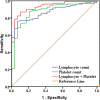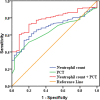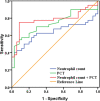Platelet distribution width as an useful indicator of influenza severity in children
- PMID: 38166827
- PMCID: PMC10759456
- DOI: 10.1186/s12879-023-08890-w
Platelet distribution width as an useful indicator of influenza severity in children
Abstract
Purpose: The present study aims to investigate the potential of platelet distribution width as an useful parameter to assess the severity of influenza in children.
Methods: Baseline characteristics and laboratory results were collected and analyzed. Receiver operating characteristic (ROC) curve analysis was used to joint detection of inflammatory markers for influenza positive children, and the scatter-dot plots were used to compare the differences between severe and non-severe group.
Results: Influenza B positive children had more bronchitis and pneumonia (P < 0.05), influenza A infected children had more other serious symptoms (P = 0.007). Neutrophil count, lymphocyte count, neutrophil-to-lymphocyte ratio (NLR), and platelet parameters performed differently among < 4 years and ≥ 4 years children with influenza. Combined detection of platelet parameters and other indicators could better separate healthy children from influenza infected children than single indicator detection. The levels of platelet distribution width of children with severe influenza (A and B) infection was significantly dropped, compared with non-severe group (P < 0.05).
Conclusions: Platelet distribution width could be a very useful and economic indicator in distinction and severity assessment for children with influenza.
Keywords: Influenza; Neutrophil-to-lymphocyte ratio; Platelet distribution width; Platelet parameters; Severity assessment.
© 2023. The Author(s).
Conflict of interest statement
The authors declare no competing interests.
Figures







References
-
- World Health Organization. Up to 650000 people died of respiratory diseases linked to seasonal FLU each year [EB/OL]. [2017-12-14].
MeSH terms
LinkOut - more resources
Full Text Sources
Medical

